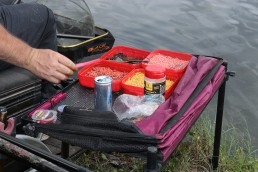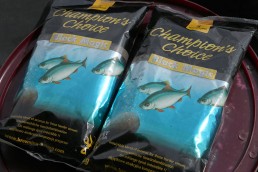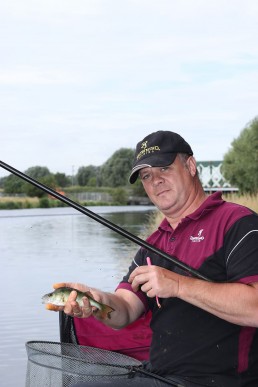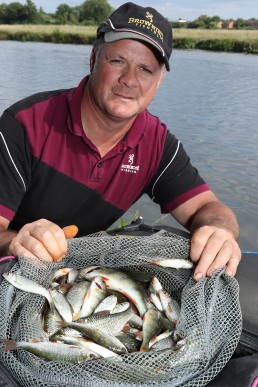Slow flowing rivers, such as the Cam, where I am today, are the home of many of the summer league matches that I fish with Browning Team Wickford. Although there are bonus fish to be caught, the great thing about rivers like this is that they are teeming with small fish at the moment. This makes them very fair venues for team fishing. Virtually every peg will produce plenty of fish, meaning the tactics used will have a significant impact on the result, rather than a few flyer pegs dominating the results.
My first aim when fishing any team match is to get a fish in the net, and get some points on the scoresheet. Once this is achieved it is a case of knuckling down and trying to catch as many small fish as possible, whilst still having the occasional look for a bonus fish further out.
It pays to fish as close in as possible, as this speeds up landing fish, but without compromising finding the right line. On this stretch of the Cam the bottom levels out fairly quickly and I am able to fish comfortably at around 7-metres in the knowledge that the bottom is flat and I am beyond the marginal shelf.
Because of the thick weed growth in the river at this time of the year it is important to bring a weed rake and spend some time clearing the area that you want to fish. I would say this is necessary on the majority of swims in the summer. Fortunately, the disturbance doesn’t put the fish off, and by the time I start fishing they will be back.

Pinkies and hemp make up my feed with a maggot hookbait.

An initial bed of groundbait will draw and hold my target fish.

Cenex Classic Mono is my choice for rigs and hook lengths.
"It has been a bite almost every put-in from small roach, perch, and dace"
To kick the swim off and lay down some feed in the area I want to catch from I start off with a few balls of groundbait made using a bag of Champions Choice Black Magic, half a bag of Etang, and some Champions Choice Krazy Sweetner. This is mixed fairly sticky as the river is around seven feet deep and I want the balls of groundbait to get to the bottom before breaking up. This helps me avoid the bleak and tiny fish that are generally up in the water. Added to the groundbait are a few dead maggots and some hemp to attract and hold the roach. To begin with I put in eight tangerine-sized balls of groundbait to lay down a carpet of feed.
After the initial baiting up I feed around 40 grains of hemp every put-in, which is around two minutes, and about 20 pinkies every couple of runs through, just to keep some bait falling through the water, creating some activity. Most of this I am sure will be mopped up by the bleak, but enough will get through to keep the roach interested.
My hookbait is a bronze maggot, which tends to pick up a slightly better stamp of fish than pinkie. In practice this has proven to be the best hookbait colour as the water is quite clear. As I am feeding hemp I will also try hemp on the hook later in the day, although this can be quite hit and miss. Some days the roach will be feeding hard on the hemp, whilst on others it can be completely ignored. Once again though, hemp does tend to pick up a better stamp of fish.
I have set up a few slightly different rigs, each of which presents the hookbait in a slightly different way. All of these are set up on no.3 Cenex solid elastic, running through my Xitan SLKP 4.5mm top kits. These are ideal for catching small fish on light lines and small hooks. I have this rigged fairly tight so that I can easily swing in small fish.
My rigs are made up using 0.10mm Cenex Classic Mono to a four-inch 0.08mm hooklength of the same material. This is a lovely clear line, with great knot strength and an accurate diameter, which allows me to fish fine as the water is relatively clear. To match the single maggot hookbaits I am using a relatively fine wire size 20 hook.
There is only a light flow on the Cam at this time of the year, but the river is relatively deep and it can be windy here out on the edge of the Fens, so I am using a 4×14 float with 10 no.9 shot strung out evenly. The float has a very fine tip to show the bites well, plus a slim body and wire stem for extra stability. The strung out rig will catch fish as the bait falls through the water, which is often how they want it presented.
The problem with a slow-sinking hookbait can be that it picks up too many bleak. If this becomes a problem I swap to a rig with the no.9’s bulked around 12-inches from the hook. When the fish are feeding really well and I need to get the bait down as quickly as possible then I will swap to a rig with the bulk at four-inches from the hook. It pays to experiment with these different permutations to see how the fish react, as on some days they want the bait falling through the water, whilst on others they want it nailed to the deck.
Today I have been practicing with some of my fellow Wickford team members and we have each been fishing a slightly different approach. The bigger fish haven’t shown, which in some respects is a good thing, as these are less likely to have an impact during match conditions. It has been a bite almost every put-in from small roach, perch, and dace, which has kept us all busy. I’ve had the odd net perch, which has boosted my weight a little, but it has really been a case of catching as many fish as possible – a style of fishing I really enjoy. We have learnt a few little things today that will hopefully serve us well in the upcoming summer league matches, on what has to be one of our favourite venues.
Paul Hyde

Add a sprinkling of Crazy Sweetner to your groundbait.

Bonus perch are always welcome.

A catch like this is worth good points in a team match.